TOKYO (Reuters) - Just as Shinzo Abe becomes Japan's longest-serving prime minister, he may be leading the world's third-biggest economy into a downturn, with little ammunition left over from his landmark "Abenomics" stimulus policies deployed seven years ago.
The three arrows of Abenomics - bold monetary easing, fiscal spending and structural reforms - boosted stock prices, brightened business sentiment and brought exporters windfall profits via a weak yen.
But years of fiscal spending and ultra-loose monetary policy have failed to fire up inflation to the BOJ's 2% target and left policymakers little firepower against another recession.
Here are the benefits brought by Abenomics and the challenges that remain for Japan's economy.
MARKET IMPACT
Many analysts say its biggest benefits were the attention the policies provoked from foreign investors, who bought Japan's shares on hopes it would finally take drastic measures to pull its economy out of deflation.
The Nikkei share average (N225) rose to around 24,450 in October 2018, its highest since late 1991, and more than doubling from levels before Abe took power in December 2012. It now hovers around 23,300.
The policies also helped reverse a damaging spike in the yen currency that hurt Japan's exporters and weighed on inflation by keeping import prices low.
The yen weakened nearly 50% to stand at 125.80 against the dollar in June 2015, from a Dec. 2012 high of 85 when Abe became prime minister.
(For an interactive graphic of market moves since 2012, click: https://fingfx.thomsonreuters.com/gfx/editorcharts/JAPAN-ABE-ECONOMY/0H001QXJL9ES/index.html)
As a weaker yen boosted manufacturers' profits, the benefits began trickling down to broader sectors of the economy as companies started hiring more.
Japan's real gross domestic product (GDP) hit 540 trillion yen in October, up 8.6% from 2012 levels. But there are signs the economy may have peaked, as the U.S.-China trade war hits exports and factory output.
(Click here for an interactive graphic of real and nominal GDP since 2012: https://fingfx.thomsonreuters.com/gfx/editorcharts/JAPAN-ABE-ECONOMY/0H001QXJS9FC/index.html)
LABOUR MARKET
Improvements in the economy and a dwindling working-age population have worsened labor shortages. The unemployment rate stood at 2.4% in September, hovering near a 27-year low hit in August. In December 2012, it was at 4.3%.
(Click here for an interactive graphic of labor-related indicators since 2012: https://fingfx.thomsonreuters.com/gfx/editorcharts/JAPAN-ABE-ECONOMY/0H001QXJH9EH/index.html)
INFLATION
Despite a prolonged economic recovery and years of heavy money printing by the Bank of Japan, inflation had failed to accelerate toward its 2% target.
After peaking at 1.4% in 2014, the core consumer price index slowed, on slumping oil costs and the hit to household spending from a sales-tax hike in 2014. Inflation never got close to 2%, and now hovers around 0.3%.
(Click here for an interactive graphic of the core consumer price index since 2012: https://fingfx.thomsonreuters.com/gfx/editorcharts/JAPAN-ABE-ECONOMY/0H001QXJF9EB/index.html)
BOJ BALANCE SHEET
The Bank of Japan kicked off a massive asset-buying program in 2013 to try and reach its 2% inflation target.
But the policy fell short, forcing the BOJ to return in 2016 to a framework targeting interest rates rather than the pace of money printing.
Despite pledging to boost bond holdings by 80 trillion yen a year, the BOJ has been steadily slowing bond purchases in what some market players describe as "stealth tapering".
(For an interactive graphic of increases in the BOJ's long-term JGB holdings and monetary base, click: https://fingfx.thomsonreuters.com/gfx/editorcharts/JAPAN-ABE-ECONOMY/0H001QXJJ9EL/index.html)
